THE INTRODUCTION: The performance of the agriculture and allied sector has been buoyant over the past several years, much of which is on account of the measures taken by the government to augment crop and livestock productivity, ensure certainty of returns to the farmers through price support, promote crop diversification, improve market infrastructure through the impetus provided for the setting up of farmer-producer organizations and promotion of investment in infrastructure facilities through the Agriculture Infrastructure Fund. The chapter discusses these aspects while also focussing on other government interventions to enhance credit availability, facilitate mechanization and boost horticulture and organic farming.
- The Indian agriculture sector has been growing at an average annual growth rate of 4.6 per cent during the last six years. It grew by 3.0 per cent in 2021-22 compared to 3.3 per cent in 2020- 21.
- In recent years, India has also rapidly emerged as the net exporter of agricultural products. In 2020-21, exports of agriculture and allied products from India grew by 18 per cent over the previous year. During 2021-22, agricultural exports reached an all-time high of US$ 50.2 billion.
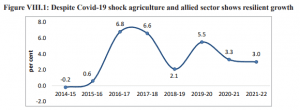
- Further, income support to farmers through the Pradhan Mantri Kisan Samman Nidhi (PM-KISAN) and the promotion of allied activities has led to diversification in sources of farmers’ income, improving their resilience to weather shocks.
- While Indian agriculture has performed well, the sector needs re-orientation in the backdrop of certain challenges like adverse impacts of climate change, fragmented landholdings, sub-optimal farm mechanization, low productivity, disguised unemployment, rising input costs, etc.
RECORD PRODUCTION OF FOODGRAINS
- As per Fourth Advance Estimates for 2021-22, the production of food grains and oil seeds has been increasing Year-on-Year (YoY). Production of pulses has also been notably higher than the average of 23.8 million tonnes in the last five years.
- However, as indicated earlier changing climate has been impacting agriculture adversely. The year 2022 witnessed an early heat wave during the wheat-harvesting season, adversely affecting its production.
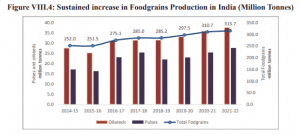
MSP TO ENSURE RETURNS OVER THE COST OF PRODUCTION
- The Union Budget for 2018-19 announced that farmers in India would be given an MSP of at least one and a half times the cost of production.
- Accordingly, the Government has been increasing the MSP for all 22 Kharif, Rabi and other commercial crops with a margin of at least 50 per cent over the all-India weighted average cost of production since the agricultural year 2018-19.
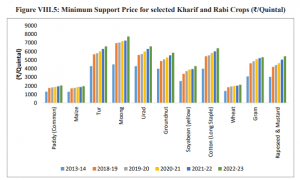
ENHANCED ACCESS TO AGRICULTURAL CREDIT
In 2021-22 also, it was about 13 per cent more than the target of ₹16.5 lakh crore. The target for the flow of credit to agriculture for 2022-23 has been fixed at ₹18.5 lakh crore.
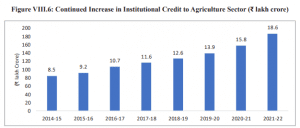
FARM MECHANIZATION- KEY TO IMPROVING PRODUCTIVITY
- As of December 2022, 21628 CHCs and 467 Hi-Tech hubs and 18306 farm machinery banks have been established. Increasing fragmentation of farm holdings requires machines that are viable and efficient for small farm holdings.
CHEMICAL-FREE INDIA: ORGANIC AND NATURAL FARMING
- India has 44.3 lakh organic farmers, the highest in the world, and about 59.1 lakh ha area was brought under organic farming by 2021-22.
- The Government has been promoting organic farming by implementing two dedicated schemes, i.e., Paramparagat Krishi Vikas Yojana (PKVY) and Mission Organic Value Chain Development for North Eastern Region (MOVCDNER) since 2015 through cluster/ Farmer Producer Organisations (FPOs) formation.
OTHER IMPORTANT INITIATIVES IN AGRICULTURE
- PM KISAN Scheme: It is a Central Sector Scheme to supplement the financial needs of land-holding farmers. The financial benefit of ₹6,000 per year is transferred into the bank accounts of farmer families through DBT.
- Agriculture Infrastructure Fund (AIF): AIF is a financing facility operational from the year 2020-21 to 2032-33 for the creation of post-harvest management infrastructure and community farm assets, with benefits including 3 per cent interest subvention and credit guarantee support.
- Pradhan Mantri Fasal Bima Yojana (PMFBY): PMFBY was launched in the 2016 Kharif season. PMFBY is currently the largest crop insurance scheme in the world in terms of farmer enrolments, averaging 5.5 crore applications every year. Farmers pay only 1.5 per cent and 2 per cent of the total premium for the Rabi and Kharif seasons, respectively, with Centre and State Governments bearing most of the premium cost. To better resolve grievances within the scheme, National Crop Insurance Portal has been developed to handle all grievances from end to end.
- Mission for Integrated Development of Horticulture (MIDH): The scheme to promote horticulture covering fruits, vegetables, root and tuber crops, spices, flowers, plantation crops etc., was introduced in 2014-15.
- National Agriculture Market (e-NAM) Scheme: The Government of India launched the National Agriculture Market (e-NAM) Scheme in 2016 to create an online transparent, competitive bidding system to ensure farmers get remunerative prices for their produce.
- Climate-Smart Farming Practices: This is slowly gaining acceptance with farmers using clean energy sources like solar for irrigation. The farmers have been incentivized to transfer electricity generated through solar to the local grid.
ALLIED SECTORS: ANIMAL HUSBANDRY, DAIRYING AND FISHERIES CATCHING UP IN RECENT YEARS
- The livestock sector grew at a CAGR of 7.9 per cent during 2014-15 to 2020- 21 (at constant prices), and its contribution to total agriculture GVA (at constant prices) has increased from 24.3 per cent in 2014-15 to 30.1 per cent in 2020-21. Similarly, the annual average growth rate of the fisheries sector has been about 7 per cent since 2016-17 and has a share of about 6.7 per cent in total agriculture GVA.

- The dairy sector is the most critical component of the livestock sector, employing more than eight crore farmers directly, and is the most prominent agrarian product.
- As a part of the Aatmanirbhar Bharat (ANB) stimulus package, the Animal Husbandry Infrastructure Development Fund (AHIDF) worth ₹15,000 crore was launched in 2020. Under this scheme, the Central Government provides a 3 per cent interest subvention to the borrower and credit guarantees up to 25 per cent of total borrowing.
- In May 2020, as a part of the ANB package, the Government of India launched its flagship scheme Pradhan Mantri Matsya Sampada Yojana (PMMSY), with a total outlay of ₹20,050 crore. PMMSY marks the highest-ever investment in the fisheries sector in India.
SAHAKAR-SE-SAMRIDDHI: FROM COOPERATION TO PROSPERITY
- To realize the vision of “Sahakar-see-Samriddhi”, a renewed impetus was given to the growth of the cooperative sector. Currently, around 19 per cent of agriculture finance is through cooperative societies.
- A full-fledged Ministry of Cooperation was established in July 2021 to provide greater focus to the cooperative sector. In addition, the Government has taken various initiatives to promote and strengthen Primary Agriculture Credit Societies (PACS), like the computerization of 63,000 functional PACS and the preparation of by-laws for enabling PACS to expand their activities.
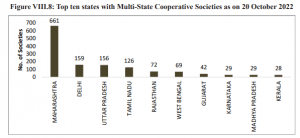
FOOD PROCESSING SECTOR-THE SUNRISE SECTOR
- The food processing industries sector has been growing at an average annual growth rate of around 8.3 per cent. As per the latest Annual Survey of Industries (ASI) 2019-20, 12.2 per cent of persons in the registered manufacturing sector were employed in the food processing sector.
- The value of agri-food exports, including processed food exports, was about 10.9 per cent of India’s total exports during 2021-22.
- Recognizing the abundant potential of the sector, the Government has been at the forefront with various interventions aimed at the development of food processing in the country.
- The Ministry of Food Processing Industries, through the component schemes of Pradhan Mantri Kisan SAMPADA Yojana (PMKSY), provide financial assistance for the overall growth and development of the food processing sector. Under PMKSY, 677 projects have been completed till 31 December 2022.
- The Ministry also launched in 2020 the Prime Minister’s Formalisation of Micro Food Processing Enterprises (PMFME) Scheme as part of the ANB Abhiyan.
- The Production Linked Incentive Scheme for Food Processing Industry (PLISFPI), launched in March 2022, has the specific mandate to incentivise investments to create global food champions. Subsequently, a PLI Scheme for millet-based products was also introduced with an outlay of ₹800 crore.
- To focus on transporting perishable food products, including horticulture, fishery, livestock and processed products, from the Hilly Areas, North-Eastern States and Tribal Areas, Krishi UDAN 2.0 version was launched in October 2021 as a six-month pilot project.
FOOD SECURITY- SOCIAL & LEGAL COMMITMENT TO THE PEOPLE OF THE NATION
- The Government is currently running the most extensive legislation-based food security programme in the world, covering about 80 crore of India’s population under the National Food Security Act (NFSA), 2013.
- The food management programme in India comprises procurement of food grains from farmers at remunerative prices, distribution of food grains to consumers, particularly the vulnerable sections of society, at affordable prices and maintenance of food buffer stock for food security and price stability.
- Till December 2022, the NFSA provided, for coverage of up to 75 per cent of the rural and up to 50 per cent of the urban population highly subsidized food grains at ₹1/2/3 per kg for coarse grains/ wheat/rice.
- To further ease the process of access to food, the Government launched a citizen-centric and technology-driven scheme in 2019 called the One Nation One Ration Card (ONORC) scheme. The ONORC system enables intra-State and inter-State portability of ration cards.
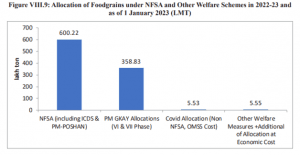
THE CONCLUSION: The performance of the agriculture sector remains critical to growth and employment in the country. Investment in the sector must be encouraged through an affordable, timely and inclusive approach to credit delivery. Intervention by the Government through PM Kisan to provide income support, strengthening of institutional finance and insurance through the PMFBY and the push given to Kisan Credit Cards as also access to machines and tools that improve productivity have been significant. A focus on the horticulture sector and the thrust towards allied activities have diversified farmers’ income making them more resilient to weather shocks. All these initiatives have led to sustainable and inclusive development of the sector.
Spread the Word
